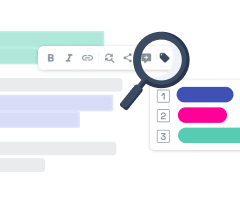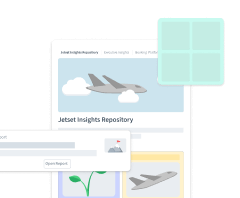
How to Present User Research Insights to Different Audiences
As UX researchers, we know about the pain points, challenges, and experiences of the people we research. This is because we heard them struggle to accomplish a task or saw them light up when speaking about a memory. Yet how can we convey our learnings to those we work with in the right depth?
Oftentimes presenting the results of user research is a crucial moment to convey what you've found to other team members and help them make the right decisions. We already discussed how to create an engaging user research presentation (with a slide template). However, to increase the impact of UX research, it's best to tailor your presentation to different audiences. This topic was recently discussed in our UX Research Munich Community talk with Moira Mastrone, a senior UX researcher from MediaMarktSaturn. She shared valuable pieces of advice on how to present user research insights and make them stick with your audience. Taking inspiration from Moira's talk, this article explores the question of how to present UX research learnings to different audiences in more detail.
The same presentation would not engage every listener. If you want to deliver the value of your research findings, an essential step to take is adapting your presentation to your audience and preparing in advance.
Read our 3 tips to make sure you are confident when sharing your research insights in front of any company role.
#1 Define your audience and presentation goals
As a first step, take some time to think about to whom you are presenting your findings. Are you planning to talk to product managers, UX designers, developers, or a different audience? What if your listeners come from various roles? Knowing that in advance will help you set your presentation goals. You might aim for informing your audience, sharing insights, convincing them, building credibility, or revealing your expertise. As a result, the type of audience and the presentation goals should guide your storytelling.
„Trying to target general audiences, such as “all stakeholders”, will often result in
muddled communications.“

First step when building a storyline, consider how much the people you are talking to know about your topic already. It's always useful to briefly explain the topic because not everyone's familiar with it. Then, come back to the goals of your talk and think of the main takeaway for your audience that you would like them to remember. Knowing that will help you stay focused during your presentation.
Here is a short checklist on what to aim for with your UX Research presentation:
Easy to understand: Make sure your audience understands your findings as quickly as possible.
Easy to care: Try to increase their empathy so that your audience feels motivated to act.
Easy to action: Make them go straight to the solution once they understand the problem.
Easy to share: Sharing and accessing research findings should be easy. Then there's simply no excuse for not seeing them.
#2 Use relevant language and examples
When your audience is defined, think of how you can speak to them in their language. Don’t forget about empathy, communication, and culture when you are presenting. Simply put, don’t use too many technical terms in front of a non-technical listener. Instead, try to double down on the strength of your qualitative research and use interview quotes as illustrative examples to drive audience engagement. See the one below, where a user struggles to reach a button:
Apart from communication, be sure your slides are adapted to suit your audience. The information you include is as important as how you present it. That means your presentation, including slides or other deliverables, should contain different sections based on the audience's goals because people in different roles don’t look for the same levels of evidence.
Let’s jump straight into examples of how to make a UX Research presentation stick with 3 different audiences:
For designers
Imagine you give a talk in front of UX designers and present them with your latest research insights. As Janet M. Six already stated, understanding the why's of users' needs and behaviors would be the most important finding for UX designers to have a holistic view of users when creating designs for them.
This is when you should go beyond the surface meaning of your data analytics. It’s even better to involve designers in the planning and research session even before the presentation. If not possible, share your research insights with a focus on the following elements to provide the most valuable learnings:
users’ characteristics and knowledge,
the tasks they are trying to perform (why, when, and where?),
users’ pain points,
the technology they are using.
Consider summarizing those findings in typical UX research deliverables, such as Personas or Journey Maps. Let your presentation walk the audience through the elements of your artifacts and make this the starting point for a deeper discussion.
For developers
If you are presenting your UX research findings to developers, focus on the information that might affect the implementation of their current project. For example, design or workflow changes. To get a better understanding of engineers’ perspectives, read the learnings from interviewing several software developers about their involvement in UX research by Taylor Palmer. In a nutshell, the author observed that sharing research insights with developers leads to better technical solutions, creating user advocates, and establishing emotional connections. Again, we think it’s always better to involve all stakeholders, including developers, to observe research sessions and get in touch with research data besides the presentation, if there’s a possibility.
In your slides, stick to a common user-centric vocabulary and highlight the relevant information. You can have a high-level summary of your learnings and explain the main findings nearby. In that way, the development team can go back to your presentation notes later and easily navigate through key insights.
However, more detailed data might also be very useful if it can help an engineer understand the user during implementation. Share a condensed version of your interview notes or short video recordings along with your presentation. The most involved engineers will get a holistic view of your research and be fully informed about its outcomes.
For managers
Sooner or later, every UX researcher presents their findings to managers, let it be a product, a project manager, or even a C-level executive. Typically, they wouldn’t have much time, so you need to be concise and illustrate how the UX research findings might impact the business goals. In short, identify all research issues that you can explain clearly, and present the main ones.
„Once you have hooked them into the problem and they are asking questions, that's the time to go into more detail or complex variants.“

Don’t spend too much time on the methodology section, unless you’re asked to do so. Instead, go strictly to the point and try to tie your findings to the company objectives or KPIs.
Make your data arguments compelling and strong for the managers to understand why they should consider your research when making decisions.
If relevant, enrich your qualitative findings with some quantitative metrics: maybe you notice a high user bounce rate or low user retention. Visualize your findings and include simple charts, graphs, or even some creditable statistics from secondary research in your presentation. As many business roles work with numbers and statistics every day, such visualizations may be an easy read for your audience.
At the same time, don’t fall into the trap of quantifying UX Research findings (no matter what!). Make sure to include video fragments from the interview. For example, you can easily create highlight reels, showing real users talking about having problems. Paired with metrics, this helps to convey your insights in the best way.
#3 Plan your presentation’s logistic
The last stage you should plan when preparing your presentation is how it will happen. Don’t forget about the basics. If you’re giving a talk in person, try making eye contact and remember that your body language is as important as your voice. If presenting remotely, make sure your listeners can hear you clearly, and that your slides are easily readable from the screen.
At the same time, communication before and after your talk plays a big role. When you send an invitation for your presentation, give your reader a hint to attract their attention and ask them when they can see the rest. Put some time pressure to stress the value of your research results. Moira suggests revealing a snippet of your research insights to make the audience interested in hearing more:
/f/99166/2870x1596/95ad4be0df/moira-video)
After giving a talk, you would probably want to share the presentation slides with your audience. Here are some tips on how to create good follow-up communication:
Start with a short introductory text, reminding when the meeting took place and what slides or deliverables were presented
Briefly explain the topic of your UX research project
Provide project background and objectives
Finally, give a summary of the main findings (though we hope your detailed presentation will be opened and explored in more depth, of course)
If available, also attach the recording of your talk
Last but not least: the presentation slides you share. Create a separate version for sharing and include additional explanations, which your audience might read on their own. Still, often the slides won’t be enough. Most probably, you will be asked to share some research notes or interview video snippets.
To avoid having a huge email attachment with the video files and archives, you can simply include a link to a sharable research report. For example, you can use Condens as an internal research repository and provide access to research summaries, video snippets, charts, and other documents within one shareable page. Many stakeholders will appreciate and benefit from an easy-way to learn more about the research highlights and experiencing them by watching selected research highlights and user quotes in an engaging format.
Wrap up
As key takeaways, remember the following:
Always pay attention to your audience, from preparing the slides to planning the communication and language around your presentation.
Think of a clear storyline, containing an intro, the main topic, and conclusions.
Synthesize your raw notes into something meaningful to your target audience and include illustrative user quotes.
Finally, give access to detailed research reports for those who want to build a full understanding of your study’s outcome.
If you tailor your presentation to your listeners' group, you will have a greater chance of making an impact.








/f/99166/2862x1560/80ecc8b8ae/moira-talk)